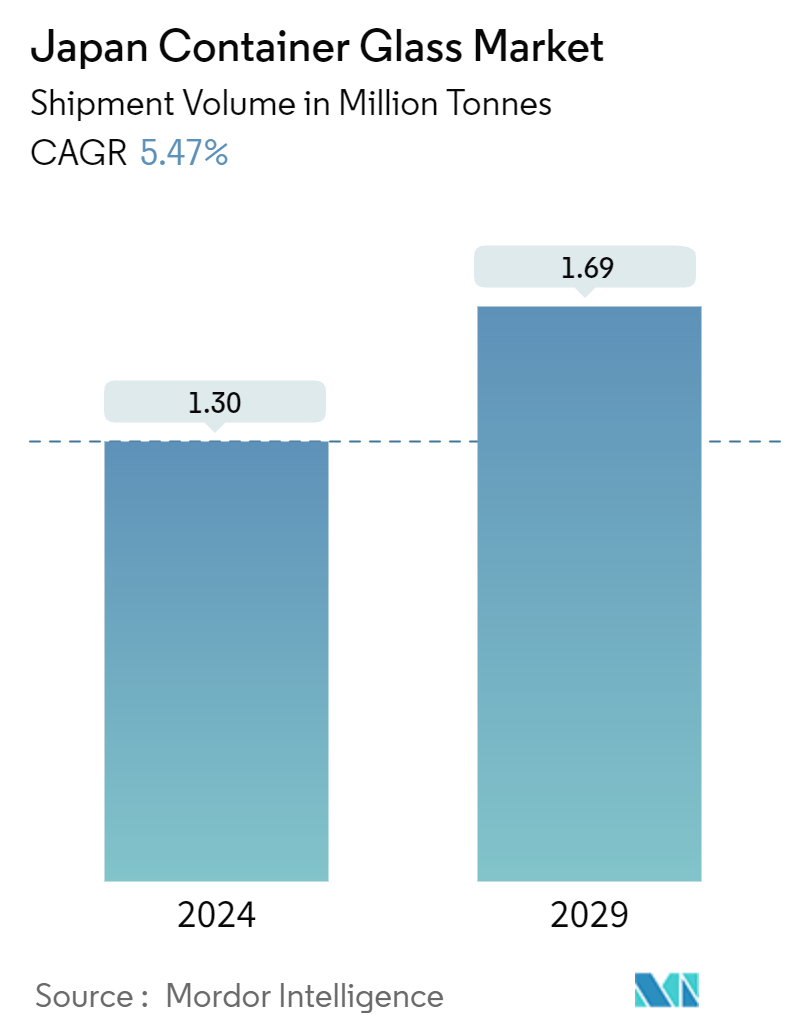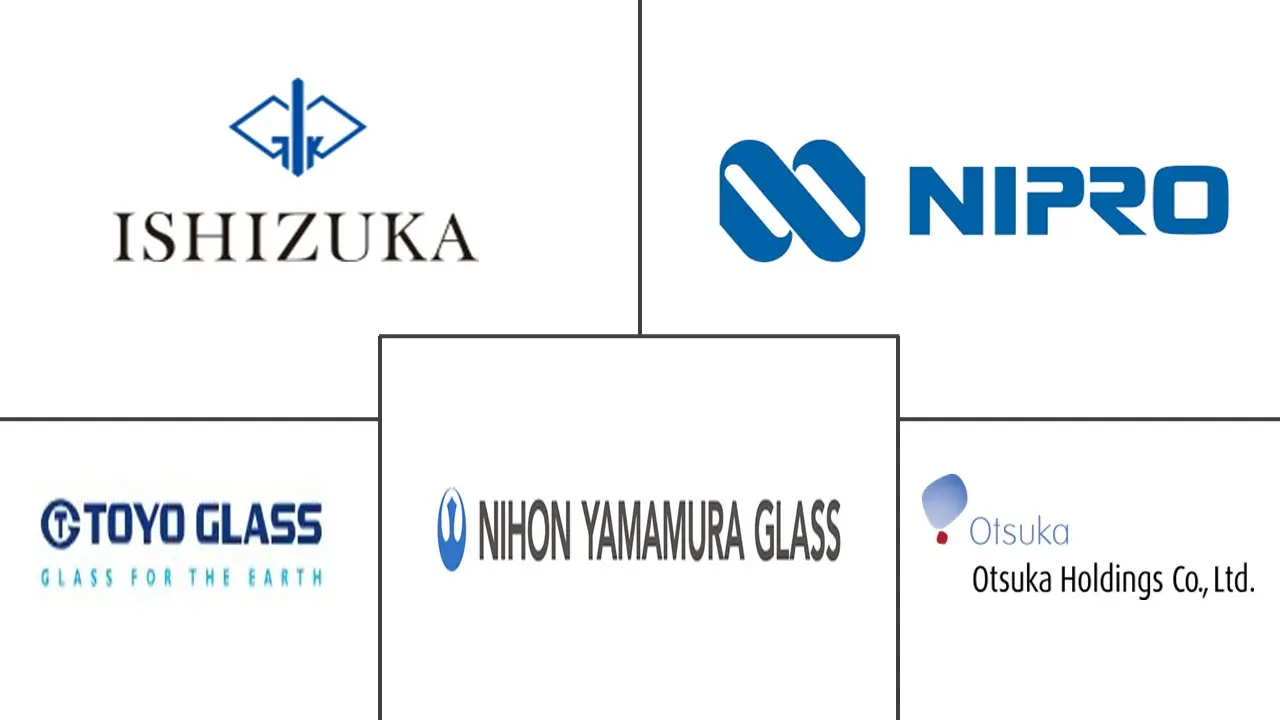Market Size of Japan Container Glass Industry

| Study Period | 2019 - 2029 |
| Base Year For Estimation | 2023 |
| Market Volume (2024) | 1.30 Million tonnes |
| Market Volume (2029) | 1.69 Million tonnes |
| CAGR (2024 - 2029) | 5.47 % |
| Market Concentration | Low |
Major Players
*Disclaimer: Major Players sorted in no particular order |
Japan Container Glass Market Analysis
The Japan Container Glass Market size in terms of shipment volume is expected to grow from 1.30 Million tonnes in 2024 to 1.69 Million tonnes by 2029, at a CAGR of 5.47% during the forecast period (2024-2029).
- Demand for glass containers is on the rise, driven by their endless reusability, recyclability, refillability, and growing acceptance across various industries. These benefits play a crucial role in fueling market expansion.
- In Japan, the push for healthier and safer packaging is driving the growth of the container glass industry. Innovations such as unique shapes, aesthetic enhancements, and embossing make packaging more attractive to consumers. Additionally, the booming food and beverage market, along with a rising demand for biodegradable and eco-friendly products, is further propelling the growth of glass packaging.
- In Japan, glass bottles dominate the beverage sector. The industry boasts efficient bottle recycling systems. As concerns about waste and global warming grow, the demand for glass containers continues to rise.
- As per the United States Department of Agriculture (USDA), Japan's non-alcoholic beverage market is valued at around USD 40 billion, with imports making up about USD 1 billion. The U.S. stands as the leading supplier of non-alcoholic beverages to Japan, with top exports being mineral water, carrot juice, and grape juice. This influx might encourage local Japanese producers to diversify their offerings, potentially introducing new flavors or types, especially those in glass bottles, to cater to changing consumer preferences and stay competitive against imports.
- Research by Japan 2 Earth (J2E) highlights a revolution in glass recycling through AI-powered sorting. This AI-driven sorting, which adapts over time, tackles labor shortages and enhances glass recycling rates by accurately categorizing glass by color and type. PFU Limited, a leading scanner manufacturer under the Ricoh Group, has introduced a cutting-edge AI tool. Leveraging image recognition technology, this tool guides robotic arms capable of sorting 70 bottles per minute, adept at distinguishing colors like brown or opaque glass. Companies like Hirosaki City's Seinan Corporation have piloted this AI system for partial automation of their glass bottle sorting.
- Nonetheless, glass production is energy-intensive, releasing CO2 from raw materials during melting. Recycling commercial glass containers poses challenges. The Japanese glass industry is actively working on initiatives to mitigate glass's environmental impact, a factor that could impede market growth.
Japan Container Glass Industry Segmentation
Glass Containers refer to clean bottles and jars made from glass. The scope excludes windows and other non-container glass products. Container glass is used in the alcoholic and non-alcoholic beverage industries due to its ability to maintain chemical inertness, sterility, and non-permeability. Glass packaging is valued for its unique properties, including its transparency, inertness, and ability to preserve the quality and integrity of its contents.
Japan Container Glass Market is Segmented by End-User Industry ((Beverages (Alcoholic Beverages (Wines and Spirits, Beer and Cider, and Other Alcoholic Beverages) and Non-Alcoholic Beverages (Carbonated Drinks, Juices, Water, Dairy-based, Flavored Drinks, Other Non-Alcoholic Beverages)), Food, Cosmetics, Pharmaceuticals, and Other End-User Industries). The Market Sizes and Forecasts are Provided in Terms of Volume (Tonnes) for all the Above Segments.
| End-User Industry | |||||||||||||||
| |||||||||||||||
| Food | |||||||||||||||
| Cosmetics | |||||||||||||||
| Pharmaceuticals | |||||||||||||||
| Other End-user Industries |
Japan Container Glass Market Size Summary
The Japan Container Glass Market is experiencing growth driven by the increasing demand for sustainable and environmentally friendly packaging solutions. The market benefits from the inherent advantages of glass, such as its recyclability and reusability, which align with the rising consumer preference for biodegradable products. The beverage industry, in particular, is a significant contributor to this demand, with glass bottles being the preferred choice due to their ability to preserve product quality. Initiatives by Japanese companies to reduce plastic waste by promoting glass container reuse further bolster market expansion. Despite challenges such as the energy-intensive nature of glass production and the complexities of recycling, the market continues to thrive, supported by strong recycling infrastructure and government regulations aimed at reducing plastic usage.
The pharmaceutical sector in Japan also plays a crucial role in the container glass market's growth, with increasing demand for glass packaging solutions for pharmaceuticals. Companies are expanding their production capabilities to meet this demand, as evidenced by investments in new glass packaging facilities. The market is moderately fragmented, with key players focusing on innovation and strategic collaborations to enhance their market presence. Additionally, the growing consumption of wine and the preference for glass packaging in the alcoholic beverage sector contribute to the market's positive outlook. Government policies and international trade agreements further support the use of glass containers, reinforcing the market's trajectory towards sustainable packaging solutions.
Japan Container Glass Market Size - Table of Contents
-
1. MARKET INSIGHTS
-
1.1 Market Overview
-
1.2 Import Export Trade Data of Container Glass
-
1.3 Industry Standards and Regulations for Container Glass Use for Packaging
-
1.4 Sustainability Trends for Packaging
-
1.5 Container Glass Furnace Capacity and Location in Japan
-
-
2. MARKET SEGMENTATION
-
2.1 End-User Industry
-
2.1.1 Beverages
-
2.1.1.1 Alcoholic Beverages
-
2.1.1.1.1 Wines and Spirits
-
2.1.1.1.2 Beer and Cider
-
2.1.1.1.3 Other Alcoholic-Beverages
-
-
2.1.1.2 Non-Alcoholic Beverages
-
2.1.1.2.1 Carbonated Drinks
-
2.1.1.2.2 Juices
-
2.1.1.2.3 Water
-
2.1.1.2.4 Dairy-Based
-
2.1.1.2.5 Flavored Drinks
-
2.1.1.2.6 Other Non-Alcoholic Beverages
-
-
-
2.1.2 Food
-
2.1.3 Cosmetics
-
2.1.4 Pharmaceuticals
-
2.1.5 Other End-user Industries
-
-
Japan Container Glass Market Size FAQs
How big is the Japan Container Glass Market?
The Japan Container Glass Market size is expected to reach 1.30 million tonnes in 2024 and grow at a CAGR of 5.47% to reach 1.69 million tonnes by 2029.
What is the current Japan Container Glass Market size?
In 2024, the Japan Container Glass Market size is expected to reach 1.30 million tonnes.

